Cataloger's Reference Shelf
CONSER Cataloging Manual
6.1. Title proper
The title proper is the only part of the title statement that must be given in every record. The title proper is used as follows:
![]() As
the main
entry, in some cases (AACR2
21.1C1)
As
the main
entry, in some cases (AACR2
21.1C1)
![]() In
links to related serials; however, it may be coupled with a corporate body main entry or replaced by a uniform title (AACR2
12.7A2)
In
links to related serials; however, it may be coupled with a corporate body main entry or replaced by a uniform title (AACR2
12.7A2)
![]() In
determining if a major change in title has occurred; title
changes are based solely on the title proper (AACR2
21.2A/LCRI
21.2A )
In
determining if a major change in title has occurred; title
changes are based solely on the title proper (AACR2
21.2A/LCRI
21.2A )
![]() As
the basis for a uniform title created according to LCRI
25.5B
As
the basis for a uniform title created according to LCRI
25.5B
![]() To
cite the serial in other files (e.g., union list, check-in)
To
cite the serial in other files (e.g., union list, check-in)
![]() To
cite the serial in related work added entries.
To
cite the serial in related work added entries.
AACR2 defines the title proper as:
The chief name of an item, including any alternative title but excluding parallel titles and other title information.
The title proper may consist of a word, phrase, acronym or initialism, the name of a corporate body, etc. Record the title proper from the chief source (i.e., the title page or title page substitute). If there is no suitable title page substitute, supply the title proper from another source in the serial or a reference source (AACR2 1.1B7).
The title proper may consist of one of the following combinations:
![]() a title consisting
of a single statement ($a)
a title consisting
of a single statement ($a)
Sports illustrated
Genes, chromosomes & cancer
Health sciences research
![]() a title and an alternative title (both $a)
a title and an alternative title (both $a)
Farmers' museum, or, Literary gazette
![]() a common title and a section
title ($a, $p)
a common title and a section
title ($a, $p)
Area wage survey. $p Washington, D.C.-Md.-Va. metropolitan area
![]() a common title with a section title and the
designation
for the section ($a, $n,
$p)
a common title with a section title and the
designation
for the section ($a, $n,
$p)
Clinical and experimental hypertension. $n Part B, $p Hypertension in pregnancy
![]() a common title and a section designation ($a and $n)
a common title and a section designation ($a and $n)
Physical review. $n A
Most serials have a title consisting of a single statement. Alternative titles are rarely found on current serials. Titles consisting of a common title/section title are more frequently encountered than alternative titles and are covered separately under CCM 6.2.
6.1.3. Transcribing the title proper
Transcribe the title proper the way it appears ( FN 1) on the chief source (AACR2 1.1B1). Do not change the words, order of words, or the spelling; however, you may change the punctuation and capitalization when necessary, as explained below. If the typography or layout of the words on the chief source causes doubt about what the publisher intends the title to be, consult other presentations of the title in the piece, such as the masthead or editorial page.
|
245 00 $a Federal facilities environmental journal. |
In Figure 6.2a. the title is unclear because it is given in conjunction with the corporate body. An examination of the masthead makes it clear that the title is Case design report. |
|
245 10 $a Case design report / $c Case Institute of Technology, Engineering Design Center, Research and Development. |
|
When a letter or word is presented once but is intended to be read more than once, repeat the word (AACR2 1.1B5).

245 00 $a Trade-marks journal = $b Journal des marques de commerce.
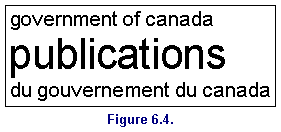
245 00 $a Government of Canada publications = $b Publications du gouvernement du Canada.
While the order of words in the title proper cannot be changed, there may be words on the piece that precede the title proper. Such words may constitute other title information, a section title, a series, or a different representation of the title that has not been selected as the title proper. For this reason, first determine what each word or phrase represents. Record words in the title proper in the order given on the piece and transcribe the other elements as appropriate.
|
In Figure 6.5., the title proper is Gas, even though it follows the subtitle High Octane Poetry. Note that the title in its proper configuration appears at the foot of the title page.
245 00 $a Gas : $b high octane poetry. |
Sometimes the typography makes it difficult to easily see the title. In Figure 6.6., the title The “In the Mood Paper” appears only in the upper left corner while the corporate body is more prominent. In Figure 6.7., the placement of the corporate body between “Illinois” and “update” makes it unclear what the exact title is. Since the title in the masthead reads “Illinois HWRIC Update” (not shown), the corporate body is retained in the title.
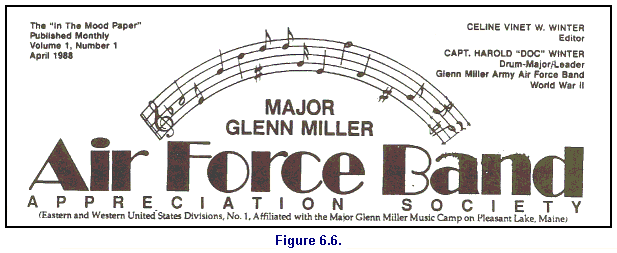
245 05 $a The "In the mood paper" / $c Major Glenn Miller Air Force Band Appreciation Society.
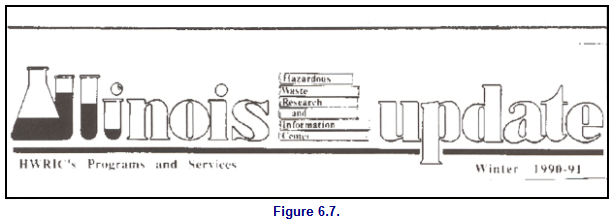
245 00 $a Illinois Hazardous Waste Research and Information Center update.
246 30 $a Illinois update
246 13 $a Illinois HWRIC update
If the title includes a sign, symbol, or other graphic representation that cannot be represented in the record, replace it with the word that is implied by the symbol or with a brief description of the symbol AACR2 1.1B1). Enclose the supplied word or words in brackets.
On piece:
I ♥ Santa Fe guide book
In record:
245 00 $a I [love] Santa Fe guide book.
500 ## $a On t.p. and cover "love" is represented by a heart symbol.
If inaccuracies appear in the title as given on the chief source, give the corrected form in the title proper and the form found on the chief source in a note/ added entry ( 500 / 246 1$; AACR2 12.1B1). In case of doubt as to whether the spelling is correct, transcribe it as found.
245 00 $a World report.
246 1# $i Issue for 1988 has title: $a Wrold report
362 0# $a 1988-
Change punctuation that is given as part of the title proper when the punctuation is the same as AACR2-prescribed punctuation. It doesn’t matter whether that particular punctuation would be used in this area or not. The following chart shows which punctuation needs to be changed and which may be retained.
PUNCTUATION USAGE IN THE TITLE PROPER (AACR2/LCRI 1.1B1 )
The following punctuation may, in some cases, be retained, changed, or omitted.
|
|||
On piece |
In record |
||
... |
(ellipses) |
-- |
(dash) |
[ ] |
(brackets) |
( ) |
(parentheses) |
: |
(colon) |
, or -- |
(dash) |
|
|
: |
(if spacing can be closed on both sides according
to |
= |
(equals sign) |
= |
(if spaces are closed on both sides) |
/ |
(slash) |
|
(if spaces are closed on both sides) |
( ) |
(parentheses) |
( ) |
|
, |
(comma) |
, |
|
-- |
(dash) |
-- |
|
|
Parentheses may be retained.
245 00 $a 501 (C)omputing news.
|
The ellipsis is replaced with a dash, leaving one space after the dash before the next mark of punctuation.
245 10 $a Proceedings– . |
|
|
The colon is replaced with either a comma or a dash.
245 00 $a Tetrahedron, asymmetry.
|
Capitalize words in the title according to AACR2 Appendix A. Always capitalize the first word in the title. Capitalize other words according to the language of the piece (AACR2 A.4A1).
1) When the title consists of a common title and section title (see CCM 6.2), capitalize the first word in the section title (AACR2 A.4D1). If a designation ($n) begins with a word, capitalize the word.
245 00 $a Journal of chemistry. $p Organic chemistry.
245 00 $a American men and women of science. $p The medical sciences.
245 00 $a Clinical and experimental hypertension. $n Part B, $p Hypertension in pregnancy.
2) Capitalize the first word of a title embedded within another title.
245 00 $a Supplement to The journal of the Friends Historical Society.
3) If the serial is the result of a merger of two serials, however, and both titles are represented in the title proper, do not capitalize the title of the second serial (AACR2 A.4C1).
245 00 $a Farm chemicals and crop life.
4) Capitalize the first word in an alternative title.
245 04 $a The literary gazette, or, Journal of criticism, science, and the arts.
Further examples of capitalization in the title proper:
245 10 $a Proceedings of the ... International Convention of the United Electrical, Radio, and Machine Workers of America.
245 10 $a Electoral College : $b [proceedings].
245 04 $a The Mailbox Club messenger.
245 00 $a WordPerfect report.
245 00 $a Colección Estudios internacionales.
While AACR2 gives explicit instructions for transcribing the title proper, the actual choice of the title proper, when there is more than one or when the title is ambiguous, is left to the cataloger. For most serials, the title proper is obvious. In other situations, however, the decision must be made as to where to begin or end the title proper or which of several different representations to select as the title proper.
The following sections provide instructions and considerations to be applied in determining the title proper. Keep in mind, however, that if a publisher clearly presents the title in one fashion on the chief source, that form is transcribed as the title proper, even though the publisher may call the publication something else in another source. This frequently occurs with words such as "magazine" or "newsletter" which appear with the title in one source and not in another.
6.1.4. Multiple titles or representations of the title
a. More than one title representing separate works
If a serial includes two or more works, each with its own title (on the same source or on different sources) and there is no collective title, apply AACR2 1.1G3. If one corporate body is responsible for all of the works (i.e., there is one statement of responsibility), give all of the titles as the title proper, separating each by a space-semicolon-space ( ; ). Give an added entry ( 246 ) for the title(s) after the first. For instructions on recording the designation when there is more than one, see CCM Module 8.
On piece:
Overview of programs for fiscal 1990
Annual report for fiscal 1989
Japan Foundation
In record:
110 2# $a Kokusai Kry Kikin.
245 10 $a Overview of programs for fiscal ... ; $b Annual report for fiscal ... / $c Japan Foundation.
500 ## $a Description based on: 1990.
515 ## $a Annual report covers the previous year.
740 02 $a Annual report for fiscal ...
When different bodies are responsible for the works, give each title followed by its related statement of responsibility. Separate each with a period.
On piece (separate sources):
Dynamit Nobel Aktiengesellschaft
Report on the business year 1963
Feldmühle Aktiengesellschaft
Report on the business year 1963
In record:
110 2# $a Dynamit Nobel AG.
245 10 $a Report on the business year ... / $c Dynamit Nobel Aktiengesellschaft. Report on the business year ... / Feldmühle Aktiengesellschaft.
710 2# $a Feldmühle Aktiengesellschaft. $t Report on the business year ...
Note that an added entry for the second title (246) is unnecessary in this example because it is identical to the title in field 245. An author/title added entry (710) is more appropriate. For further instructions on title added entries, see CCM Module 7.
b. One work, more than one title
When there is only one work in the serial, and the chief source has separate words or phrases, each of which could be construed to be the title proper, select one as the title proper. First be sure that one of the titles isn’t an unnumbered series (searching the LC/NACO Authority File could help determine this). To determine which should be the title proper, consult other sources in the serial and consider the nature of each title. Does one qualify or further explain the other or are they equally independent of each other? In the latter case, consider whether one is more typographically prominent than the other.
In Figure 6.11., there are two separate titles, each of which could be the title of the serial. Because the title Collection Agency Directory is more prominent on the chief source, it is chosen as the title proper. In this case, the cataloger has chosen to record the other title in an "At head of title" note. It could also be recorded as other title information (see CCM 6.3.3.).
245 00 $a Collection agency directory. 246 1# $i At head of title: $a Collection agency report |
c. Title in more than one language
If a title is given on the chief source in more than one language, select as the title proper the title in the language that comprises the main portion of the serial (AACR2 1.1B8). If the text is equally divided or it is difficult to determine, choose the first title that appears on the piece. CONSER catalogers will most often apply the latter provision of the rule (i.e., choosing the title from the order given). However, in cases where the first title given is in a language not represented in the text (e.g., Latin or Greek), it is best to choose another title.
d. Initialism and full form of title
When an acronym or initialism appears on the chief source in addition to the spelled out or "full form" of the title, use the full form as the title proper (AACR2 12.1B2) and record the acronym or initialism as other title information (AACR2 12.1E1a).
Prior to the 2002 revision of AACR2, when both the full form and initialism appeared on the chief source, the acronym/initialism was transcribed as the title proper when it was the only form of the title given in other sources. The change was made to harmonize practices with ISSN. According to CONSER practice, do not change existing records where the acronym or initialism is the title proper, even when doing so might avoid a major change (LCRI 12.1B2 ).
|
In Figure 6.12., the full form is the title proper, according to AACR2 12.1B2, even though the initialism is typographically prominent.
245 00 $a Literary market place : $b LMP. 246 30 $a LMP |
|
|
In Figure 6.13., while the acronym "BETA" is presented in other areas, the full form is chosen as title proper according to AACR2 12.1B2. Note that in this case two types of other title information are given (the second statement appears directly below the title on the chief source).
245 00 $a Bulletin of experimental treatment for AIDS : $b BETA : a publication of the San Francisco AIDS Foundation. 246 30 $a BETA |
If, however, the full form and initialism do not appear on the same source, the one appearing on the chief source is the title proper and the one appearing on another source is given as a note (246); do not record as other title information.
On t.p.:
TDR
On spine:
The drama review
245 00 $a TDR.
246 18 $a Drama review
Apply AACR2 12.1B2 also when the initialism and full form are not exactly the same:
245 00 $a American book publishing record : $b BPR.
Or when the acronym is embedded in the title:
245 00 $a Mathematics teacher education & development : $b mted.
246 30 $a Mted
[On piece, the acronym is embedded in the title, i.e. the first letter of the words are colored to form the acronym of the title.]
Note: Do not confuse letters that represent the corporate body with initialisms of the title. For example, in the title ORALL newsletter, "ORALL" stands for the corporate body – Ohio Regional Association of Law Libraries – not the title. |
|
Apply AACR2 12.1B2 also when an additional word or words appears with the initialism.

245 00 $a Computer-assisted English language learning journal : $b CAELL journal.
246 30 $a CAELL journal
246 3# $a Computer assisted English language learning journal
An alternative title is a second, equally independent title that appears with the first title and is preceded by the word "or" or its equivalent in another language. Alternative titles are most often found on 19th and early 20th century serials; they are rarely encountered on current serials.
Give both titles as the title proper, separated by commas. Give an added entry for the alternative title; in addition, give the first title without the word "or" in field 246 when it consists of fewer than five words so that it can be searched alone, but do not make an added entry (LCRI 21.30J ).

245 $a Farmers' museum, or, Literary gazette.
246 30 $a Literary gazette
246 20 $a Farmers' museum
6.1.5. Where does the title proper begin?
Names and words that appear on the same line with the title are generally transcribed as part of the title (e.g., Fiscal year 1992 program report would be 245 10 Fiscal year ... program report). In order to determine whether the name of a person, corporate body, or another serial that appears above the title is part of the title proper, consider first whether the name is grammatically linked to the title.
![]() If
the name is linked by the use of an apostrophe or a grammatical case ending,
include the name in the title proper, according to AACR2
1.1B2.
If
the name is linked by the use of an apostrophe or a grammatical case ending,
include the name in the title proper, according to AACR2
1.1B2.
![]() However,
words that serve as an introduction to the title, such as “welcome to...,”
“presents...,” should be omitted according to AACR2
1.1B1.
However,
words that serve as an introduction to the title, such as “welcome to...,”
“presents...,” should be omitted according to AACR2
1.1B1.
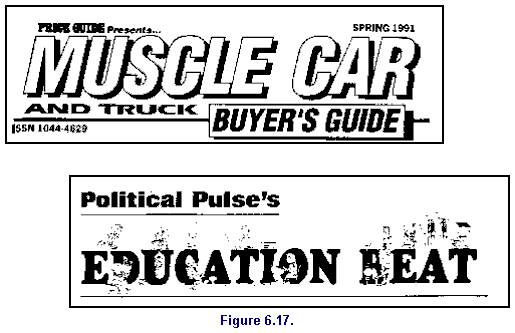
In both of these examples, the name of another serial is given. The use of the word “presents” in the first example makes it possible to interpret this statement as introductory wording that can be omitted ( FN 2). In the second example, however, the name of the other serial is given alone and is grammatically linked and, thus, is transcribed as part of the title.
245 00 $a Muscle car and truck buyer's guide.
246 1# $i Title appears on item as: $a Price guide presents– muscle car and truck buyer's guide
245 00 $a Political pulse's education beat.
246 30 $a Education beat
Names of bodies, persons, or other publications that are not grammatically linked may be transcribed in or omitted from the title proper, depending on the nature of the name, its proximity to the title, and the presentation of the title in other sources. When in doubt, consider other presentations of the title that are given in the serial (AACR2 12.1B3/LCRI 12.1B3 ).
For example, a corporate body that appears above the title without a grammatical link may be included in the title proper or transposed as the statement of responsibility. When unsure whether to include the name in the title, look to see if the title appears elsewhere, with or without the name of the corporate body (AACR2 12.1B3). Consider formal statements found on the editorial page, cover, etc. rather than informal statements appearing in the preface or text.
In Figure 6.18., the cataloger has chosen not to include the corporate body in the title, probably due to the typography. |
|
110 2# $a Association of Research Libraries. 245 10 $a Newsletter / $c Association of Research Libraries. 246 17 $a ARL newsletter 246 3# $a Association of Research Libraries newsletter |
|
|
In Figure 6.19., the acronym of the corporate body appears more as an integral part of the title. The cataloger has included the name in the title.
245 10 $a NCHS ... in review. |
The decision to include or not include the name of the body in the title is not as critical as it once was since a change on a later issue in the placement of the body is considered to be a minor title change and does not require a new record ( FN 3) (AACR2 21.2C2b). In the past catalogers avoided putting the corporate body in the title (see also Module 16).
In Figure 6.20., the title could be transcribed as "Annual report" or "Prince Edward Island Energy Corporation annual report" since the title is typographically indistinguishable from the corporate body. |
|
110 2# $a Prince Edward Island Energy Corporation. 245 10 $a Annual report / $c Prince Edward Island Energy Corporation. 246 3# $a Prince Edward Island Energy Corporation annual report or 110 2# $a Prince Edward Island Energy Corporation. 245 10 $a Prince Edward Island Energy Corporation annual report. 246 30 $a Annual report |
|
When cataloging conference publications, remember that the name of the conference constitutes the statement of responsibility in most cases when there is a title proper. In Figure 6.21., the title is "Proceedings."
111 2# $a Reliability and Maintainability Symposium. 245 10 $a Proceedings / $c Annual Reliability and Maintainability Symposium. |
|
6.1.6. Where does the title proper end?
The title proper can be short or long.
245 00 $a Ms.
245 00 $a New York State's list of approved in-state private schools and special act school districts for children with handicapping conditions and out-of-state schools with New York State contracts.
In general, do not abridge a serial title. AACR2 1.1B4, which allows a long title proper to be abridged, is generally used only for older, pre-20th century works on which the title often covered the entire title page.
Record phrases that are grammatically linked as part of the title proper, even though a secondary phrase may seem more like other title information or may incorporate the name of a responsible corporate body.
245 00 $a Fees and taxes charged insurance companies under the laws of New York together with abstracts of fees, taxes, and other requirements of other states for ...
not
245 00 $a Fees and taxes charged insurance companies : $b under the laws of New York together with abstracts of fees, taxes, and other requirements of other states for ...
[even though the first part of the statement is in larger type]
Is the phrase "from Oregon Graduate Center" part of the title or should it be recorded as a statement of responsibility? In the masthead the title is given as "Visions." We might think of “from” as similar to the word “of” and transcribe the whole phrase as part of the title. A 246 field should be given in this case for the word “Visions” alone. |
|
245 00 $a Visions from Oregon Graduate Center. 246 30 $a Visions |
|
|
In this example, the words "for the new generation" indicate the audience of the serial and the phrase is included in the title. An added entry is given for "Images" alone because it is typographically prominent.
245 00 $a Images for the new generation. 246 30 $a Images |
245 00 $a International gas report. |
|
The phrase "Covering the gas and gas liquids industry worldwide," which is set apart by typography, explains the nature of the contents and thus, might qualify as other title information. This is the type of phrase that could be included in a quoted note according to AACR2 12.1E1c, 12.7B6.1.
Occasionally, the title page of a serial includes a phrase that indicates the inclusion of another work. Consider whether each issue of the serial is likely to include this work determining whether to record the phrase in the title proper. If the phrase is omitted, it may be given in a note (see also CCM 6.1.7.d.).
On piece:
Annual report 1974 including report of the proceedings of the annual conference held on 3rd, 4th, 5th, and 6th June 1973
In record:
245 10 $a Annual report.
500 ## $a Reports for <1974-> include the Report of the proceedings of the annual conference.
6.1.7. What to omit (AACR2 12.1B7)
Omit information that is specific to one or several issues. Such information includes designations (i.e., numbers or dates) that vary from issue to issue and names of persons that are likely to change on a frequent basis.
a. Designations: numbers and/or dates
In most cases, a number or date found at the beginning, end, or middle of a title constitutes the issue’s designation and is omitted from the title statement ( FN 4). Record the omitted designation, including associated words or phrases, in the numbering area (field 362 ) or in the "Description based on" note (see Module 8).
On piece:
1989 Report of the Statistical Reporting Service
In record:
245 10 $a Report of the Statistical Reporting Service.
500 ## $a Description based on: 1989.
On piece:
5th Directory of services covering 1988/89
In record:
245 10 $a Directory of services covering ...
500 ## $a Description based on: 5th (1988/89).
Omit the number or date when it varies from issue to issue and, depending on where the omission occurs, replace the omitted data with ellipsis (...) (AACR2 12.1B7). If the omission occurs at the beginning of a title, do not use the ellipsis; likewise, if it occurs at the end, do not use the ellipsis, unless the date or number omitted was grammatically linked to the rest of the title. A grammatical link is a word such as "for" or "in" that links the title to a date, number, or a phrase that contains the date or number. When the ellipsis is given at the end of the title statement, do not give an additional period.
On piece:
1989 Annual report
In record:
245 10 $a Annual report.
On piece:
Annual report for 1989
In record:
245 10 $a Annual report for ...
On piece:
Annual report
Fiscal year 1989
In record:
245 10 $a Annual report.
500 ## $a Description based on: Fiscal year 1989.
On piece:
Memoria 1988
In record:
245 10 $a Memoria.
On piece:
Washington State 1989 budget and statement of accounts
In record:
245 10 $a Washington State ... budget and statement of accounts.
Omit all words and numbers that constitute the chronological designation from the title (LCRI 12.1B7 ).
On piece:
Annual report for the fiscal year 1 July 1990 through 30 June 1991
In record:
245 10 $a Annual report for the fiscal year ...
500 ## $a Description based on: 1 July 1990 through 30 June 1991.
If there is more than one number/date omitted from different places in the title, use an ellipsis for each. See Module 8 and LCRI 12.3C1 for information on recording multiple chronological designations.
On piece:
Outlook for 1989 and report for 1988
In record:
245 10 $a Outlook for ... and report for ...
500 ## $a Description based on: 1989.
515 ## $a Outlook for <1989-> includes report for <1988->
Retain numbers or dates in the record when:
1) the number or date is an integral, unchanging part of the title.
245 00 $a 73 magazine for radio amateurs.
245 00 $a 12-year stock record.
2) the number remains constant on each issue and designates a section title (CCM 6.2.).
b. Names, numbers other than designations, and other data that is omitted
When the title includes data, such as names or numbers (other than designations), that is likely to change frequently, even if not on every issue, omit the data from the title. Examples of such omissions are names of officials and prices that relate to the title.
On piece:
The report of Governor Robb to the State Legislature [made up]
In record:
245 14 $a The report of Governor ... to the State Legislature.
On piece:
Frommer's guide to Washington, D.C. on $35 a day
In record:
245 00 $a Frommer's guide to Washington, D.C. on $... a day.
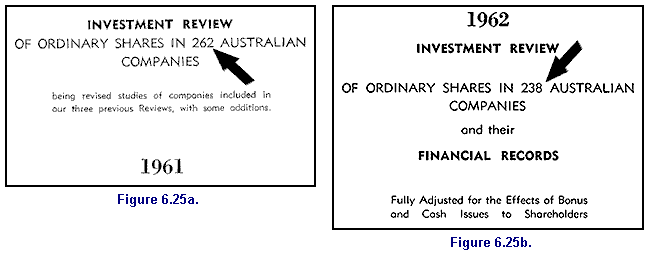
245 00 $a Investment review of ordinary shares in ... Australian companies.
500 ## $a Title varies slightly.
500 ## $a Number of companies varies with each issue.
Some serials, in addition to having a title common to all issues, also have additional titles that reflect the theme or subject of the individual issue. The additional title is called a " distinctive title." Distinctive titles are not usually recorded because adding each new title to the record would be impractical; however, a note may be given to indicate the presence of distinctive titles on the piece (AACR2 12.7B4 ) e.g., Each issue also has a distinctive title.
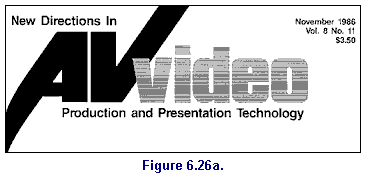
"New directions in production and presentation technology" is a distinctive title because it represents the focus of this issue. From the presentation on the chief source it could be considered to be part of the title proper but an examination of the title in other sources shows that the title proper is AV video. The distinctive title is not given in the record but a general note is given. 245 00 $a AV video. 500 ## $a Some issues have distinctive titles. |
|
d. Earlier title of the serial
Occasionally, when the title of a serial changes, the earlier title is included on the piece with the new title to alert readers to the fact that this is the same serial. This also occurs when one serial absorbs another and the publisher wishes the reader to be aware of this fact. After a period of time, the earlier title is usually dropped. For this reason, omit the earlier or absorbed title from the title proper (AACR2 12.1B1), but record it in linking entry field 780 .
On piece:
International gas report, incorporating World gas report
In record:
245 00 $a International gas report.
780 05 $t World gas report [2nd ind. 5 = Absorbed:]
Summary: omissions from the title proper
![]() Numbers and dates that designate an
issue of a serial
Numbers and dates that designate an
issue of a serial
![]() Any
other number or word that is likely to change with every, or almost every,
issue
Any
other number or word that is likely to change with every, or almost every,
issue
![]() Distinctive
titles
Distinctive
titles
![]() The
earlier title of the serial or the title of an absorbed serial
The
earlier title of the serial or the title of an absorbed serial
AACR2 1.1B3 allows for the name of a person or corporate body to be given as the title proper when there are no other words that could be construed as the title. For serials, this situation often occurs with conference publications when the name of the conference alone appears on the chief source or with administrative reports that contain only the name of the corporate body on the chief source. When a name is given as the title proper, supply a brief title in brackets as other title information. When possible, use words found elsewhere in the piece.
Apply AACR2 1.1B3 only when no title is found prominently in the item. For example, if a title appears on the cover and the page that would normally be the title page contains only the name of a corporate body, choose the cover as the title page substitute. The other page is not considered to be a title page because there is a title and it is not included on this page (see Module 3).
In the rare instances when there is no title page or other page that could be used as a title page substitute, take the title from other sources (when available), or from a reference source (AACR2 1.1B7). Give the title within brackets. Cite the source in field 500 (e.g., Title from text; Title from [reference source], etc.). If a title can’t be found in any of these sources, supply a brief title within brackets.
In Figure 6.27., there is no true title, only the name of the corporate body. The name of the body is given as the title proper and other title information is supplied (AACR2 1.1E6) using a term found in the piece that describes the work. The other title information is given in brackets because it does not appear on the chief source.
110 2# $a Hawaii Institute of Geophysics. 245 10 $a Hawaii Institute of Geophysics : $b [report]. |
See also: